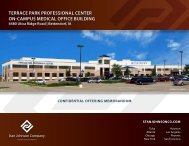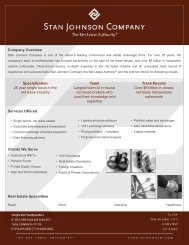FSED - Stan Johnson Company
FSED - Stan Johnson Company
FSED - Stan Johnson Company
You also want an ePaper? Increase the reach of your titles
YUMPU automatically turns print PDFs into web optimized ePapers that Google loves.
The Investor Market<br />
As more FEDs are built in the years ahead, investors will have the opportunity to purchase these facilities as net leased investment<br />
opportunities. Hospitals will likely look to third-party developers to construct these, off-campus, and non-core facilities as they will<br />
seek to keep their available capital invested in the operations, or available for physician practice and competitor acquisition<br />
opportunities.<br />
The typical FED will be between 10,000 to 15,000 square feet, with a cost to construct averaging between $350 - $450 per square<br />
foot, depending on the market and land cost. The high price per square foot to construct will pose as the biggest challenge for net<br />
lease investors analyzing this type of investment. It is important to note that the most successful FEDs are located on high-traffic<br />
retail out parcels therefore; proposed FEDs should not sacrifice business opportunities in favor of cheaper land costs. In<br />
comparison to a Walgreens drug store, (a popular net leased investment) the cost to build is considerably higher, can have far less<br />
favorable credit supporting the lease and is extremely ‘special purpose’ in its construction and design. With average NNN rents for<br />
FEDs starting at $38+ per square foot, investors will have legitimate concerns with regard to their ability to replace the rental<br />
income stream, should the tenant default. A net lease investor will look for longer lease terms (15 to 20 years), annual rent<br />
escalations and more favorable cash-on-cash yields as protection against these negative elements.<br />
In comparing the FED to a typical retail net lease investment the FED does offer some attractive advantages. FEDs typically achieve<br />
breakeven performance with annual volume of 13,000 to 15,000 patient visits. For a facility open 24/7, 365 days per year this<br />
translates into a modest average of only 38 patients per day. It is anticipated that FED EBITDA/rent coverage ratios could easily<br />
exceed 4 times rent which, when compared to the average retailer’s rent coverage ratio of 1.25, this should increase the appeal of<br />
the asset for the net lease investor. An additional highlight to this investment type has been the access to attractive debt. Lenders<br />
are very interested in the relative safety offered by investments in healthcare real estate, and the competition for the product<br />
amongst lenders is providing favorable debt terms in the market.<br />
Key Points<br />
<br />
<br />
<br />
<br />
<br />
<br />
Developers and FED tenants should look for sites near well-known retail outlets, as this will increase customer traffic as well as<br />
brand awareness within a new market.<br />
Proximity to a popular retail center will make the real estate investment more attractive to net lease investors.<br />
Proposed development projects sponsored by hospitals or healthcare systems will be viewed far more favorably in the<br />
investment market than projects sponsored by independent operators or operator/hospital joint ventures.<br />
Require long-term lease commitments of 15 to 20 years. (A project this expensive requires a demonstration of commitment on<br />
the part of the tenant)<br />
Look for opportunities in rural communities where emergency options are limited to older, functionally obsolescent facilities.<br />
Credit behind the lease will be heavily scrutinized and when present, reflected in the pricing paid for the investment.<br />
Conclusion<br />
Freestanding Emergency Departments represent an evolution in the way healthcare services are delivered, and provide<br />
tremendous benefits to healthcare providers and consumers alike, by offering much needed services in a more cost efficient<br />
environment. As more and more investors recognize the impressive growth and demographics driving the healthcare industry,<br />
competition to own healthcare real estate will continue to increase. FEDs should be very attractive to net lease investors, if the<br />
leases are structured appropriately.<br />
Toby Scrivner, Director<br />
<strong>Stan</strong> <strong>Johnson</strong> <strong>Company</strong>




